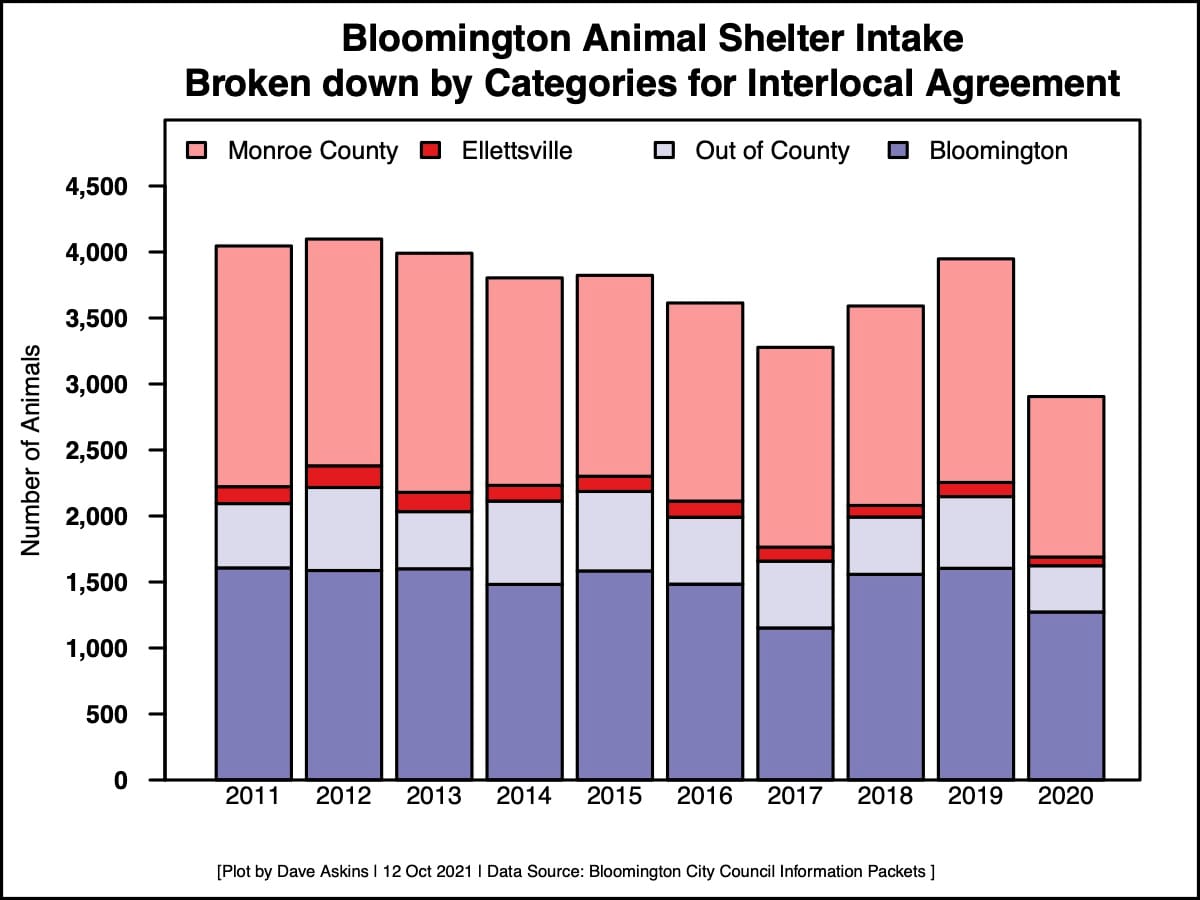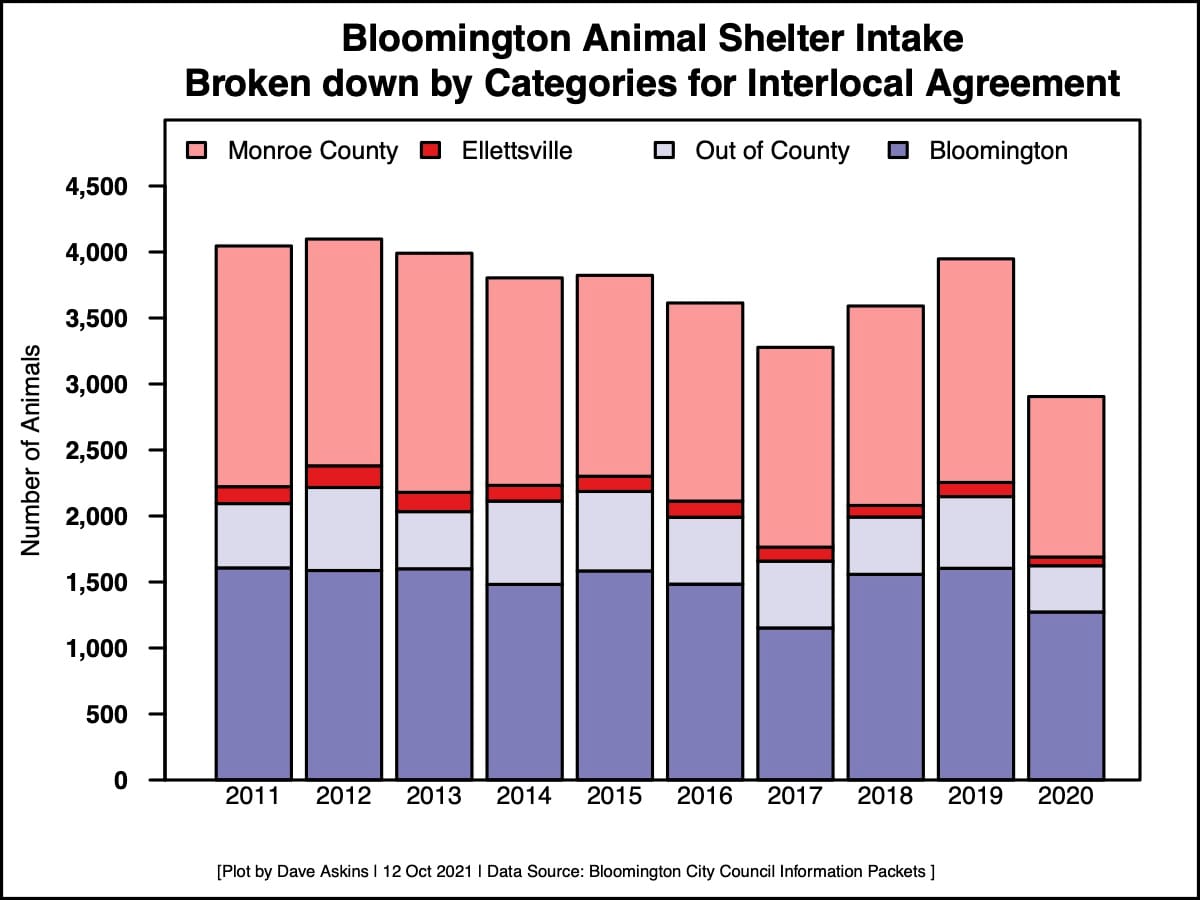Bloomington signs off on animal care agreement with Monroe County, Ellettsville



At its Wednesday meeting, Bloomington’s city council approved an agreement with the other governments in the county that spells out how Bloomington’s cost is covered for animals surrendered to the city shelter by non-city county residents and county animal control officers.
On the county’s side, the interlocal agreement was approved last year by county commissioners and the county council.
Under the terms of this year’s agreement, the amount paid to Bloomington by Monroe County will be $342,912. Ellettsville will pay $18,612. That’s a total of $361,524.
The total is based on 1,282 animals that were surrendered to the shelter in 2020 by Monroe County or Ellettsville, at a net cost of $282 per animal.
It’s an arrangement that was controversial in the past. During public commentary time on Wednesday, county councilor Geoff McKim told the city council that he had supported the interlocal agreement when it came in front of the county council and encouraged the county council to support it.
McKim continued, “This is a terrific example for the public for how the city and county really can work together—which I know not everyone believes can be done.”
When he started his service on the county council 12 years ago, the agreement was controversial, McKim said. He added, “ But through a lot of work by the staff on both sides, we’ve come up with an arrangement that’s fair and predictable and beneficial to all parties, and it’s no longer been controversial.”
On Wednesday, the agreement was not disputed by city councilmembers.
Responding to a question from councilmember Sue Sgambelluri, Bloomington’s director of animal care and control Virgil Sauder said that revenue from adoption fees stays with the city of Bloomington.
The formula used to calculate the amounts that each government unit owes starts with the actual expenditures at the shelter. From that number, revenue from adoption fees is subtracted to get a net cost.
Responding to a question from councilmember Dave Rollo, Sauder reported that 12 to 15 percent of the city shelter’s overall intake comes from outside the county. In 2020, Sauder said, the number of animals received from outside Monroe County boundaries was 350.
Under Bloomington’s city code, the fee for a resident outside of Monroe County boundaries to surrender an adult dog or cat is $20.
There is no charge for a resident of Bloomington, Ellettsville or an unincorporated area of Monroe county to surrender an animal to the shelter.
Rollo asked Sauder if anyone ever leaves without surrendering the animal when they are told they have to pay a fee. Sauder said it has happened, but it’s very rare. The shelter staff are good at counseling people, he said.
If someone is trying to find a home for an animal they can’t keep, the shelter offers “courtesy listings” on its webpage of animals available for adoption.
Sauder told Rollo that if the staff thinks the animal to be surrendered would in danger if the shelter did not take it in, then staff will work with the person to take in the animal.
Monroe County and Ellettsville accounted for about 44 percent of the shelter’s 2020 total of 2,905 animals. That’s about average for the last decade, which has been 46 percent.
The 2020 total of 2,905 is 11.4 percent lower than the previous low over the last 10 years—which was 3,278 in 2017. The high was in 2012, when 4,098 animals were taken in by the shelter.
Last fall, responding to an emailed question from The B Square, Sauder wrote: “Last year was definitely an unusual year for the shelter.”
Sauder wrote that the 2020 drop was likely not due to a single factor, and there are several theories that might account for it.
Sauder wrote that the decrease from 2011 to 2017 could be partly analyzed as the impact of ongoing policy and community changes that began years ago—spay-and-neuter efforts, feral cat policies, as well as societal views of animals.
The reversal of the downward trend in 2018 came in the same year the shelter completed its renovations. “Unfortunately, as many shelters across the nation have seen, [renovations] led to increased intake for a few years,” Sauder wrote.
In the future, Sauder expects to see shelter numbers at just below 2017 levels.
As specific changes connected to 2020, Sauder pointed to home rental changes that did not occur, due to changes in hiring practices, rent assistance and other factors.
Sauder said ordinarily people who are moving, and either can’t find pet-friendly housing or do not feel it is best to take their pets to the new home, will surrender their pets to the shelter. A reduction in that kind of scenario has the potential for a big impact, because owner-surrendered pets are about half of the shelter’s normal intake.
Sauder indicated that another 2020-specific change was the launch of the shelter’s “courtesy posting” program—which allows people to use the city’s advertising platforms to find a new home for their animals, instead of depending on the shelter. The courtesy posting program has diverted a small number of animals from the shelter, Sauder wrote.
As another possible theory that might partly account for the 2020 drop, Sauder pointed to a change in human habits, connected to the pandemic. More people at home and outside allowed them to take the time to locate the home of a wayward pet without shelter intervention, Sauder wrote.




Comments ()